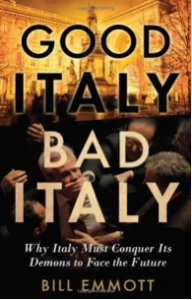 Review by Amb. (ret.) Gwen Clare
Review by Amb. (ret.) Gwen Clare
Good Italy Bad Italy, Why Italy Must Conquer Its Demons to Face the Future by Bill Emmott, Yale University Press, 2012, ISBN 13: 978-0300186307, 304 pp. , $19.78 hardcover, $16.50 Kindle.
Emmott’s book might have been titled more appropriately Bad Italy with Some Good Despite all Odds, A Warning of What the West Faces If It Doesn’t Get Its Act Together. Emmott, a former editor-in-chief of The Economist and a regular columnist for The Times in London, is also the author of Rivals: How the Power Struggle Between China, India and Japan will Shape our Next Decade. Readers of The Economist will feel right at home with Emmott’s journalistic account of what ails Italy today and how the last two decades, particularly during Prime Minister Silvio Berlusconi’s nine years in power, failed to address the underlying problems that brought about the earlier financial crisis of 1992-94.
While Emmott salts the book with success stories to show Italy does have pockets of success, and even excellence, I found these examples unpersuasive as counterbalances to all the bad he details. It’s good to know that Ferraro candy maker employs 22,000 people in 18 factories around the world and Luxottica, the world’s top eyewear company, employs 60,000 people worldwide. But why wouldn’t the eighth largest economy in the world boast successful enterprises like these?
Particularly underwhelming were his accounts of social movements attempting to cut down on the payment of protection money to local gangsters and, even more challenging, take on the mafia. Even Emmott, while giving the good folks engaged in these efforts a lot of ink and credit for their courageous work, admits that these groups are barely making headway in tackling these endemic drags on Italy’s success. In fact, he notes that Italy’s mafias continue to thrive and grow despite demonstrations and arrests of leaders.
Emmott points out that Italy began the latest world debt crisis with conservative banks, high rate of household savings, and a large and impressive manufacturing sector, all factors that set it apart from the European economies under initial attack. He then goes on to explain that none of this saved Italy—with its public debt at 120% of its annual gross domestic product and minimal growth—from onerous bond costs. It has joined Portugal, Ireland, Greece, and Spain as a source of concern in the Eurozone. But, as the world’s eighth largest economy, and the third largest in the Euro area, Italy is too big to fail. That worries Europeans, and it should worry the reader.
The Bad Italy section highlights restrictive labor laws and over-powerful labor unions, an unworkable judicial system, excessive public spending, inefficient state enterprises, stagnant productivity and politicians who, perhaps, will make the American reader feel that our dysfunctional Congress could be worse.
Those of us who first think of delicious food, wonderful wines, awe inspiring sights, and high end consumer goods when Italy comes to mind might share my surprise at some of Emmott’s statistics. In 2010, Transparency International’s poll of corruption perceptions put Italy in the 67th place, just behind Rwanda. The unworkable judicial system places Italy at 157th out of 183 countries in terms of enforcing contracts, according to the World Banks’s ‘Doing Business’ rankings for 2011. Sclerotic justice also ranks the country at 156 out of 181 in terms of the average length of civil legal proceedings, outpacing Djibouti but falling behind Gabon and Guinea.
While the author goes out of his way to say that Italy’s problems are not just in the South, he notes that 98% of Sicily’s regional government budget goes to current spending, mainly salaries, leaving nothing for capital projects. Perhaps the most troublesome figure Emmott cites is how many Italian workers it takes to produce Fiats when compared to Fiat operations elsewhere. In Poland, 17% more employees produce seven times as many cars as those produced in an Italian plant. This disparity may be explained by the average 30% of Fiat’s Italian production workers who are involved in unscheduled stoppages every day.
And, it’s not just labor issues that hold Italy back. In a world where creative or knowledge intensive work is more important each day, only 13.6% of Italians aged 25 to 64 had tertiary education, comparable to Portugal but lower percentage than Mexico. For comparison, the figures for Germany are 24.3, 26.8 for France, 31.8 in Britain, and 40.3 for the U.S. While Italians have won Nobel awards for work done outside Italy, the most recently awarded prize given for work actually done in Italy was in 1963. By comparison, since 1980, Germany has won 26 Nobel Prizes, France 14, and Switzerland 8 for work done domestically.
After weeks of wrangling, Berlusconi has recently teamed up with Italy’s Northern League to compete for the country’s national and regional elections next month. Should their alliance win nationally, Berlusconi says he’s not interested in returning to the office of Prime Minister. “The role of prime minister has no real power,” he said, adding that he would be better suited to becoming the next finance minister, “which would allow me to demonstrate once again that I have no political ambitions, that I don’t consider politics as something that brings me any advantages.” Berlusconi’s return to national office, particularly as Finance minister, would kill Italy’s chances for meaningful reform.
Given all the above, how easy will it be for Italy to succeed? I don’t share Emmott’s belief that Good Italy is capable of overtaking Bad Italy anytime in the near future. What does this mean for the Eurozone and the world economy? These are questions I came away with after reading this book.
Bill Emmott’s highly readable book does a very good job at describing Italy today, leaving the reader to form her own judgment about the long-term prospects for Italy, Europe, and the Western World at large.![]()
American Diplomacy is the Publication of Origin for this work. Permission to republish is freely granted with credit and a link back to American Diplomacy

